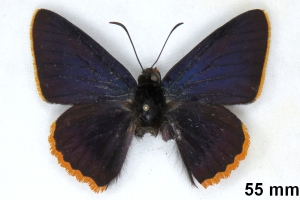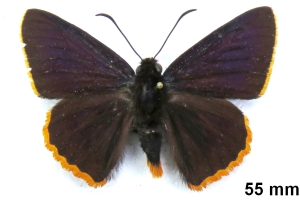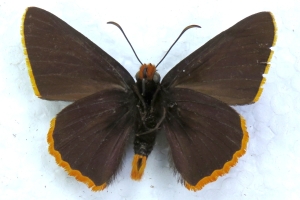Version 4 / 7 vom 5. August 2023 um 14:41:12 von Jürgen Rodeland
Länder:

 +1Kontinente:MA
+1Kontinente:MA


 +1Kontinente:MA
+1Kontinente:MA2. Diagnose
2.1. Männchen
1-2: Holotypus ♂, Honduras, La Paz, Municipality of Opatoro, 14°08’35.1”N, 87°51’56.8”W, 2000 m, leg. Robert J. Gallardo, e.l. 29. März 2018 (fot.: Robert J. Gallardo, Fotos bearbeitet: Michel Kettner), coll. National Museum of Natural History, Washington, D.C., USA
3-4: Paratypus ♂, Honduras, La Paz, Opatoro, Guajiquiro, 2000 m, 14°08’35.1’’N 87°51’56.8’’W, leg. Robert J. Gallardo, 29. März 2018 (coll. & fot.: Robert J. Gallardo, Fotos bearbeitet: Michel Kettner)
3. Weitere Informationen
3.1. Faunistik
Nach Mielke, Brockmann & Mielke (2022) kommt die Art in Honduras vor.
Locus typicus: Honduras.
(Autor: Michel Kettner)
3.2. Literatur
- Brockmann E., Mielke, C. G. C. & O. H. H. Mielke (2022): Hesperiidae III: New World Pyrrhopyginae, short text and plates. — In: E. Bauer & T. Frankenbach (ed.) (2022): Butterflies of the World 50: 40 p. + 76 pl. Keltern.
- Erstbeschreibung: Gallardo, R. J. & N. V. Grishin (2021): Orange fringes, crenulate hindwings and genomic DNA identify a new species of Jonaspyge from Honduras (Hesperiidae: Pyrrhopyginae). — Tropical Lepidoptera Research 31 (1): 48-52. [PDF auf journals.flvc.org]
- Mielke, O. H. H., Brockmann, E. & C. G. C. Mielke (2022): Hesperiidae II: New World Pyrrhopyginae, detailed text. — In: E. Bauer & T. Frankenbach (ed.) (2022): Butterflies of the World 49: 120 pp. Keltern.
- Orellana A. (2008): Pyrrhopyginae de Venezuela (Lepidoptera: Hesperioidea: Hesperiidae). — Entomotropica 23 (3): 177-291. [PDF auf saber.ucv.ve]







